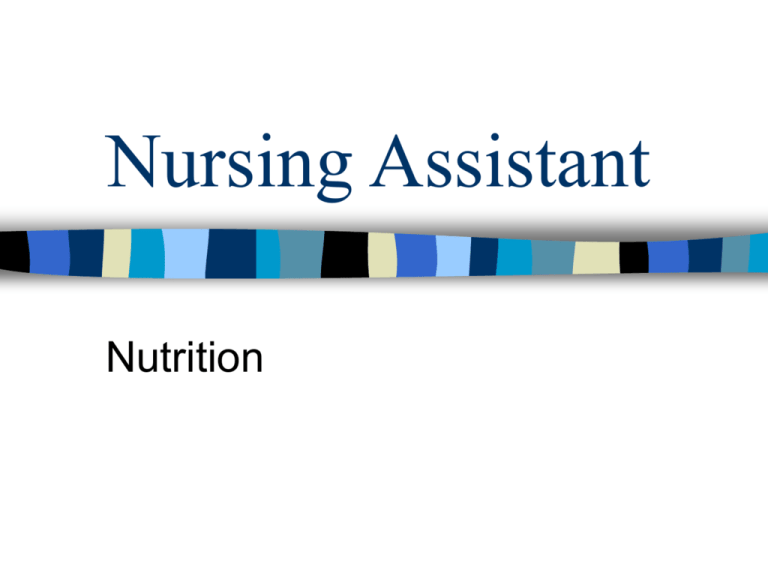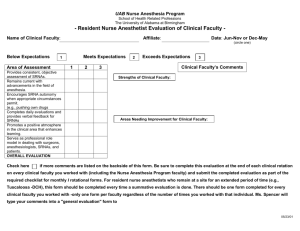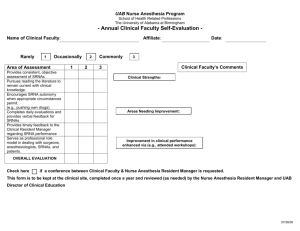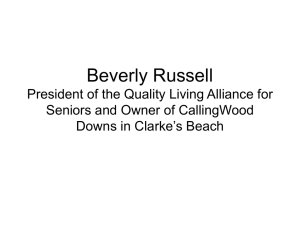Nursing Assistant
advertisement

Nursing Assistant Nutrition Body’s need for food & fluids Provide energy for daily living & bodily functions Promote growth & repair of tissue Provide necessary substances for regulation of bodily fluids Nutrition Science of foods & their relationship to health – Essential to good health – Composed of sufficient nutrients to meet the body’s requirements Common Nutrients Carbohydrates – Grains – Pastas – Breads – Cereals – Fruits – Vegetables Proteins Eggs Milk Meat Fish Nuts Poultry Fats Oils Cream Cheese Meat fats Butter Vitamins Vegetables Fruits Milk Minerals Eggs Dried fruit Potatoes Fish Milk Dietary fiber Raw fruits Raw vegetables Whole grains Fluids Water Juices Other beverages Food Pyramid www.mypyramid.gov Serving sizes based on age, gender, & activity level Vegan Vegetarian AND no animal by products Check www.mypyramid.gov for specifics Special nutrient needs of elderly Age related changes – – – – – – Fewer calories needed, decreased activity Digestive disturbances = add vitamins & minerals Meds may interfere with digestion & nutrient use Poor oral hygiene, ill-fitting dentures Ability to taste decreased Many common diseases interfere with eating & or the ability to use nutrients – Social isolation = interference with appetite Food allergies – know status & check for additives (peanuts, shellfish, wheat) Therapeutic diets Low sodium Diabetic Low fat Liquid – – – – – Full liquid Clear liquid Thickened liquids Nectar thick Honey thick Special consistency diets Mechanical soft Pureed Soft Responsibilities of nursing assistant Check that residents receive diets ordered, check arm bands with tray Report any diet related problems – preferences, difficulties, N & V, anorexia Assist drs & nurses to evaluate fluid balance, accurate I & O Calculate food intake according to facility, if eats all, eats 100% Offer alternate menu with refusal If alternate refused, report to licensed nurse Technique for feeding Provide comfortable & enjoyable atmosphere – Sit at eye level – Maintain a positive attitude when feeding Provide assistance if needed Serve residents in room if unable to join others in dining area (best choice is dining area) Alternate liquid & solid food Steps Wash hands Check diet card for name, diet order, special instructions, & allergies Make sure food matches info on card Remove tray from food cart, see that all items are there Knock & pause before entering room Introduce self Check armband Explain procedure Steps cont. Lower side rail Place tray on overbed table If in dining room, remove food items & place on table – remove tray Place a towel or clothing protector Remove plate cover Seat yourself at eye level Arrange food, butter bread, season food Steps cont Describe or show food before giving it to resident Use adaptive devices as indicated Use straws & thickeners as indicated Offer small portions of solids ( no more than ½ spoonful) Alternate solids & liquids Ask what they would like Put food on unaffected side of mouth Monitor for pocketing & swallowing difficulties Remove tray when resident is finished Prevention of choking High risk residents – – – – CVA Neurological disease Trauma to head, neck, or throat Dementia Close supervision when eating Follow individual feeding plan Cut food into small pieces, offer in small amounts, wait until each portion is chewed & swallowed before more is given Choking cont. Notify licensed nurse if dysphagia – – – – – – – – Long time before swallowing Swallows several times with each bite Frequent throat clearing Difficulty handling foods/fluids in mouth Wet gurgling voice Pocketing food Unintentional weight loss Feeling by resident that food is sticking Choking cont Proceed at resident’s pace – don’t rush Portion should be chewed & swallowed before more is given Sit down while feeding helpless resident Use adaptive equipment as indicated Recognition of signs of choking Universal sign Inability to speak, cough, breathe Cyanosis Loss of consciousness HEIMLICH MANEUVER DIETARY MODIFICATIONS Affiliated with religions and/or cultures Ask if there are any preferences Ask family of residents who cannot communicate Alternate ways to offer nutrition Tube feedings – Ordered by doctor when resident unable to eat – Started by a licensed nurse – Your responsibility • • • • • • Monitor for tubing kinking or pressure Monitor level of feeding KEEP HOB AT 20 – 30 DEGREES AT ALL TIMES DO NOT LOWER HOB EVEN WHEN REPOSITIONING Never turn off pump – notify nurse of alarm Notify nurse if signs of aspiration Intravenous infusion Ordered by physician Started by licensed nurse Your responsibility – Monitor IV for kinks, twisting, pressure, or obstruction – Report • • • • • • • • Alarms C/o pain or burning at site Swelling or redness at site Fever SOB Bleeding of fluid leakage at IV site Disconnected IV tubing Empty IV container




